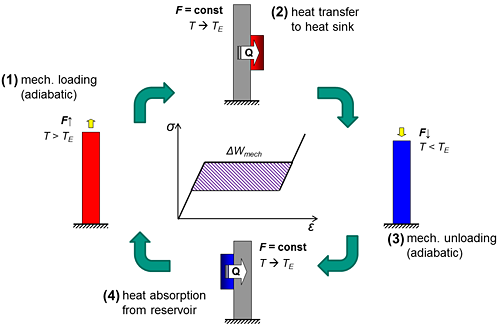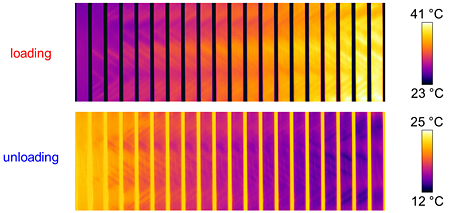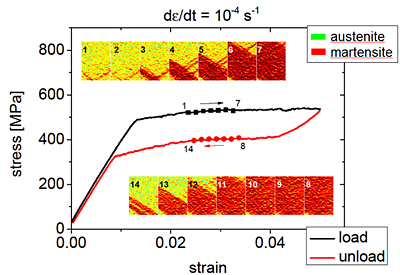Elastocaloric Microcooling
Basic Principle
Shape memory alloys (SMAs) like NiTi show besides the shape memory effect so-called caloric effects. Here, release/absorption of thermal energy is based on a stress-induced phase transformation that occurs between the two solid phases martensite and austenite. During this kind of phase transformation referred to as pseudoelasticity, crystallographic variants are aligned in the direction of applied load resulting in a large length change of the material (up to 8%) without damage. Upon releasing the load, the SMA transforms back to austenite and restores its initial shape. The austenite-martensite transformation is exothermal, the corresponding reverse transformation endothermal. Figure 1 shows how a closed cooling cycle can be designed based on the elastocaloric effect. (1) Upon application of the force F, latent heat is released and the temperature of the material rises. (2) Heat is released, while the material is brought into contact to a heat sink. (3) During subsequent force release, latent heat is absorbed and the material cools down. (4) This heat can be absorbed form a heat source brought into contact.
 |
|
Figure 1: Closed cooling cycle based on the elastocaloric effect. |
Due to the large latent heat, elastocaloric cooling based on SMAs can in principle reach a similar efficiency as state-of-the art refrigerators, while completely avoiding the use of environmentally harmful greenhouse gases. Moreover, due to favorable scaling behavior (NiTi can be processed to foils and films having a thickness of below 10 µm) SMAs are suitable for miniaturized cooling applications, e.g., in minimal invasive surgery or microelectronics. The use of SMA foils has the additional advantage that heat transfer between active material and environment can be fast.
Local thermal and mechanical performance
The suitability of a SMA for elastocaloric cooling depends primarily on two properties. First, the heat transfer in a transformation cycle should be as high as possible. A material having the latent heat L and heat capacity Cp will heat (cool) by ΔT = L/Cp during transformation (reverse transformation) under adiabatic conditions. Latent heat can be determined by differential scanning calorimetry (DSC). The actual temperature changes also depend on heat transfer with the environment through heat conduction and convection. They can be observed by infrared thermography during cyclic tensile tests. During slow tensile tests, part of the latent heat is exchanged already during transformation. The maximum temperature change is only reached through sufficiently fast load change without exchange of heat (adiabatic limit).
 |
|
Figure 2: Time series of temperature profiles in an SMA stripe during stress-induced martensite transformation (top) and reverse transformation (bottom), determined by infrared thermography. |
The second important property is the mechanical performance that can be studied in tensile tests. In order to induce the stress-induced martensitic transformation, a certain mechanical load has to be applied. During reverse transformation, on the other hand, the material can perform work like a loaded spring. Due to hysteresis, the work is not the same in both cases. Thus, part of the work ΔW is lost in a complete transformation cycle.
The stress-induced transformation does not proceed homogeneously, but rather locally by formation and propagation of so-called Lüders bands showing abrupt changes of strain. These can be observed by the digital image correlation (DIC) method, see Figure 3. For application in a cooling device, the (local and macroscopic) mechanical properties have to be repeatable over many cycles, i.e., degradation should be negligible.
 |
 |
|
|
Figure 3: (left) Setup for tensile testing. (right) stress-strain characteristic of a pseudoelastic sample. Colored insets show a time series of local strain profiles in the sample center. |
||
The performance of an elastocaloric material is expressed by the coefficient of performance COP = L/ΔW, which relates the transported heat to the mechanical work input. For NiTi and NiTi-based alloys, the COP can exceed values of 10.
|
Tensile test on an elastocaloric Ni-Ti-stripe specimen. The graph represents the stress-strain characteristic. On the right side the temperature development is shown. The inset shows the local strain of a part of the specimen. Download Video: MP4 format, 19.3 MB |
|
Miniature heat pump demonstrator based on the elastocaloric effect. Download video: MP4 format, 5.4 MB |
Contact:
Current Student Research Projects (IMT):
https://www.imt.kit.edu/3153.php
Further Information:
- DFG-Schwerpunktprogramm SPP1599
- H. Ossmer, C. Chluba, S. Kauffmann-Weiss, E. Quandt, and M. Kohl, TiNi-based films for elastocaloric microcooling - Fatigue life and device performance, APL Mater. 4, 064102 (2016); doi: 10.1063/1.4948271.
- H. Ossmer, F. Wendler, M. Gueltig, F. Lambrecht, S. Miyazaki, and M.Kohl, Energy-efficient miniature-scale heat pumping based on shape memory alloys, Smart Mater. Struct. 25 (2016) 085037 (13pp).
- H. Ossmer, C. Chluba, M. Gueltig, E. Quandt and M. Kohl, Local Evolution of the Elastocaloric Effect in TiNi-Based Films , Shape Memory and Superelasticity 2015:14, DOI: 10.1007/s40830-015-0014-3
- H. Ossmer, F. Lambrecht, M. Gültig, C. Chluba, E. Quandt, M. Kohl, Evolution of temperature profiles in TiNi films for elastocaloric cooling , Acta Materialia 81, 2014, pp. 9–20
- H. Ossmer, C. Chluba, B. Krevet, E. Quandt, M. Rohde and M. Kohl, Elastocaloric cooling using shape memory alloy films , J. Phys.: Conf. Ser. 476 (2013), 012138

